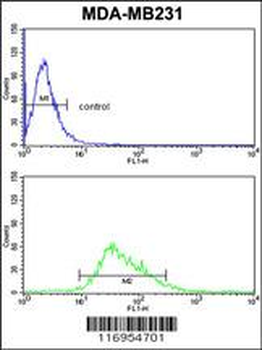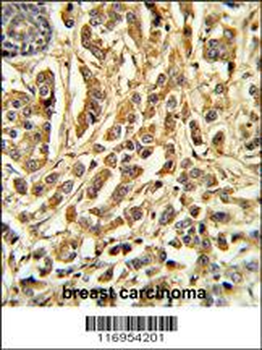You have no items in your shopping cart.
CYP21A2 Antibody (Center)
Catalog Number: orb1928797
| Catalog Number | orb1928797 |
|---|---|
| Category | Antibodies |
| Description | Purified Rabbit Polyclonal Antibody (Pab) |
| Species/Host | Rabbit |
| Clonality | Polyclonal |
| Clone Number | RB16954 |
| Tested applications | FC, IF, IHC-P, WB |
| Reactivity | Human |
| Isotype | Rabbit IgG |
| Antibody Type | Primary Antibody |
| Dilution range | IF: 1:10~50, WB: 1:1000, IHC-P: 1:50~100, FC: 1:10~50 |
| Form/Appearance | Purified polyclonal antibody supplied in PBS with 0.09% (W/V) sodium azide. This antibody is prepared by Saturated Ammonium Sulfate (SAS) precipitation followed by dialysis against PBS. |
| Conjugation | Unconjugated |
| MW | 56001 Da |
| Target | This CYP21A2 antibody is generated from rabbits immunized with a KLH conjugated synthetic peptide between 216-246 amino acids from the Central region of human CYP21A2. |
| UniProt ID | P08686 |
| NCBI | NP_000491.4, NP_001122062.3 |
| Storage | Maintain refrigerated at 2-8°C for up to 2 weeks. For long term storage store at -20°C in small aliquots to prevent freeze-thaw cycles |
| Alternative names | Steroid 21-hydroxylase, 21-OHase, Cytochrome P-450 Read more... |
| Note | For research use only |
| Expiration Date | 12 months from date of receipt. |

Western blot analysis of CYP21A2 Antibody (Center) in MDA-MB435 cell line lysates (35 ug/lane). CYP21A2 (arrow) was detected using the purified Pab.

Confocal immunofluorescent analysis of CYP21A2 Antibody (Center) with 293 cell followed by Alexa Fluor 488-conjugated goat anti-rabbit lgG (green). DAPI was used to stain the cell nuclear (blue).

CYP21A2 Antibody (Center) flow cytometric analysis of MDA-MB231 cells (bottom histogram) compared to a negative control cell (top histogram). FITC-conjugated goat-anti-rabbit secondary antibodies were used for the analysis.

Formalin-fixed and paraffin-embedded human breast carcinoma reacted with CYP21A2 Antibody (C-term), which was peroxidase-conjugated to the secondary antibody, followed by DAB staining. This data demonstrates the use of this antibody for immunohistochemistry; clinical relevance has not been evaluated.



